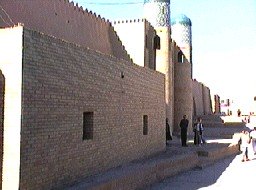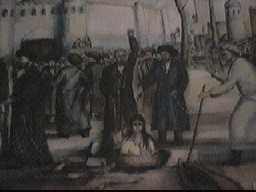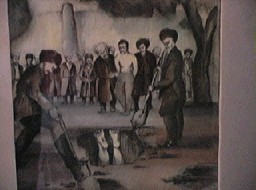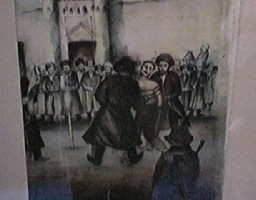The name 'Zindan' means darkness in Persian and refers to the fact that most Central Asian jails took the form of underground pits - something that was not possible in Khiva due to the high water table. Originally the prison consisted of three smallish rooms - an outer guard room (which is now destroyed), a jail for tax offenders and an inner room for those accused of committing more dangerous crimes. Inmates were never kept incarcerated for very long: tax offenders were imprisoned until relatives had paid off their debts while the more hard-core prisoners were shackled for seven days with a water and toilet break just once a day. If their families did not come up with the requested blood money by the end of this period the prisoner would simply be taken out and executed.
Today a musty-looking collection of shackled dummies are manacled to a wooden block in the inner cell while the debtors section contains instruments of torture and paintings of executions. These include a drum for announcing executions, a whip that was immersed in salty water before being used, stocks for immobilizing the slaves when being sold in the market place and some formidable looking swords. The sketches adorning the walls lack somewhat in artistic merit but make up for in terms of content. Each one tells the story of cruel and barbaric demise meted out by the Khan.
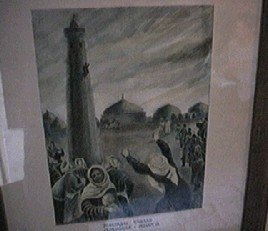 Tower of death
Tower of deathThis young woman went against her father's wishes by spurning her rich seventy-year-old husband-to-be in favour of her true love. They secretly eloped but tragedy struck and they were caught and sentenced to death. He was hanged while she was buried up to the chest and then stoned with hard balls of mud; a slow and agonizing death. The girl's father threw the first stone and remained bare-headed as a sign of shame until his daughter was dead.
This particularly vindictive style of execution was reserved exclusively for adulterous women. They were placed in sacks of wild cats which were beaten to drive the cats into a frenzy, resulting in an eventual death by laceration.
Being thrown head first into a pit and then being buried alive was another popular form of execution. The most infamous case of mass killing by this method was carried out by Samarkand's Amir Timur (known in the west as Tamerlane), who built a tower out of the still-living bodies of his foes and cement.
Sharpened wooden stakes were driven into the ground and victims were thrust upon them so that the stake would eventually protrude from their backs or neck. Sometimes an impaled man would live for two days on the stake, only dying when the point comes through his shoulders or back.



